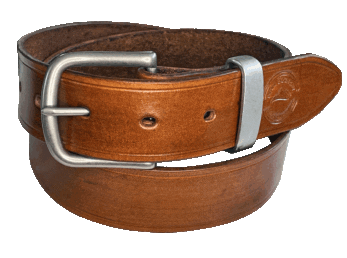Handmade Full-Grain
Men’s Leather Belts

Which Belts are The Best Leather Belts
When you invest in a quality leather belt, you expect durability and longevity. However, even in the best leather belts, some changes to the belt’s appearance and shape over time are entirely normal and even desirable, especially with natural materials like full-grain leather. Understanding these changes can help you appreciate the unique qualities of your belt.

Beautifully Hand Made Belts
That Last
An example of a Cheap Leather Belt. It may save you money upfront, but they lack durability, style, and quality, costing you more in the long run. Invest in a belt that lasts.
OUR REVIEWS
Conforming to Your Shape
Leather is a natural material that softens and stretches as it is worn. A new leather belt may start out stiff, but with regular use, it will gradually mould to your body’s contours. This is not a sign of poor quality, it’s a hallmark of genuine leather adapting to its owner. Over time, this conforming process enhances comfort and gives the belt a personalized fit.
Visible Buckle Marks
Where the belt passes through the buckle, you may notice creases or wear marks forming. Again, even with the best leather belts, this is a natural result of the leather bending and flexing repeatedly in the same spot. These marks don’t compromise the belt’s integrity; they’re simply a sign of use and the material’s responsiveness to pressure.
A Patina That Tells a Story
High-quality leather develops a patina over time. This subtle sheen and darkening in areas of frequent contact or bending is a visual record of the belt’s journey with you. Rather than detracting from its appearance, a patina adds character and uniqueness to the belt, making it truly your own.
Signs of Quality, Not Wear and Tear
If your belt doesn’t stay perfectly straight or shows buckle marks, it doesn’t mean it’s wearing out prematurely. In fact, these changes are more common in premium, full-grain leather belts compared to synthetic or lower-grade options, which may crack or peel instead of softening gracefully.
How to Care for a Leather Belt Showing These Changes
While these characteristics are normal, proper care can ensure your belt lasts for years:
- Condition the Leather: Use a leather conditioner to keep the material supple and prevent it from drying out.
- Store It Properly: Hang your belt or roll it gently to maintain its shape without causing unnecessary stress.
- Avoid Over-Tightening: Pulling the belt too tight can accelerate wear at the buckle area.
Embrace the Natural Evolution of Leather
A quality leather belt is not a static accessory, it evolves with you. The subtle changes in shape, marks near the buckle, and the development of a patina are all part of its charm. Rather than viewing these characteristics as flaws, consider them a testament to the authenticity and craftsmanship of your belt. They tell a story of quality, use, and timeless style.